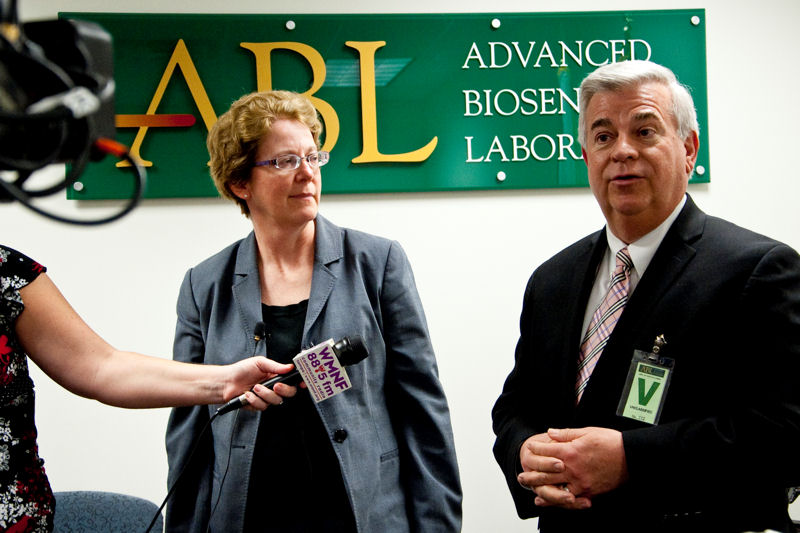
From left, Nancy Stoner, assistant administrator of the Office of Water in the U.S. Environmental Protection Agency (EPA), and Jeff Eger , Water Environment Federation (Alexandria, Va.) executive director attended a Water Innovation tour at the University of South Florida (USF; Tampa). Stoner unveiled EPA’s new Blueprint for Integrating Technology Innovation during the tour. Photo courtesy of Aimee Blodgett, USF.
On March 27, Nancy Stoner, assistant administrator of the Office of Water in the U.S. Environmental Protection Agency (EPA), unveiled the Blueprint for Integrating Technology Innovation during a Water Innovation Tour at the University of South Florida (Tampa).
Jeffery Lape, EPA Office of Science and Technology deputy director; Jeff Eger, Water Environment Federation (WEF; Alexandria, Va.) executive director; and Matt Ries, WEF chief technical officer, attended the tour, where Stoner introduced EPA’s blueprint.
The blueprint calls for national support of emerging technologies in water treatment, testing, and reuse, as well as for reducing barriers to greater collaboration and innovation between academic, industry, and government researchers, according to a University of South Florida news release. The blueprint offers EPA’s support for increasing innovation and technology to advance clean and safe water and sustainable water utilities, the blueprint says.
“The United States is facing serious challenges to its water resources, including deteriorating infrastructure, continued population growth and development, impacts of climate change, emerging contaminants, widespread nutrient pollution and strains on water supply,” the blueprint says. “Accelerating innovation and technology will help address the complex challenges facing America’s water resources.”
The blueprint identifies examples of utilities using cutting-edge technologies and innovations to reduce energy consumption and produce energy, as well as other resources, such as nutrients. It also describes areas where these technologies and innovations could be most useful, including
- water and wastewater infrastructure as the need for funding grows;
- water reuse as water resources dwindle;
- water quality monitoring as managers need more data at less cost;
- water quality and quantity issues related to energy production;
- resiliency of water infrastructure as the occurrence of extreme weather events increases; and
- improving water quality in waterways by addressing nonpoint sources of pollution, rebuilding ecosystems, addressing invasive species, and restoring watersheds.
Blueprint outlines way to support new technologies
The blueprint addresses EPA’s work to identify barriers to implementing new technologies. This includes concerns that federal, state, and local requirements discourage acceptance, adoption, and use of technologies, the blueprint says.
It also outlines actions EPA has taken and information the agency has released to increase understanding and help alleviate these problems. Working with WEF and other industry organizations, EPA has determined that solutions will require public–private partnerships, technology evaluation, support for innovative technology and risk-taking, and communication and education efforts.
The blueprint is “intended to be an evolving plan” that will be updated with information reflecting ongoing conversations within EPA, as well as with external partners and stakeholders, it says. It outlines a set of actions to take, including partnering with organizations such as WEF.
Collaborations with WEF include supporting the WEF and Water Environment Research Foundation (Alexandria, Va.) Leaders Innovation Forum for Technology (LIFT) program, as well as WEF’s efforts to reimagine wastewater utilities as “utilities of the future” that recover water, energy, and nutrients as resources, the blueprint says.
Other actions include communicating goals and actions, institutionalizing technology innovation, exploring ways for regulations to foster technology innovation, and supporting technology innovation cluster initiatives.
For more information, see http://water.epa.gov/blueprint.cfm.
— Jennifer Fulcher, WEF Highlights








May 16, 2013
Featured